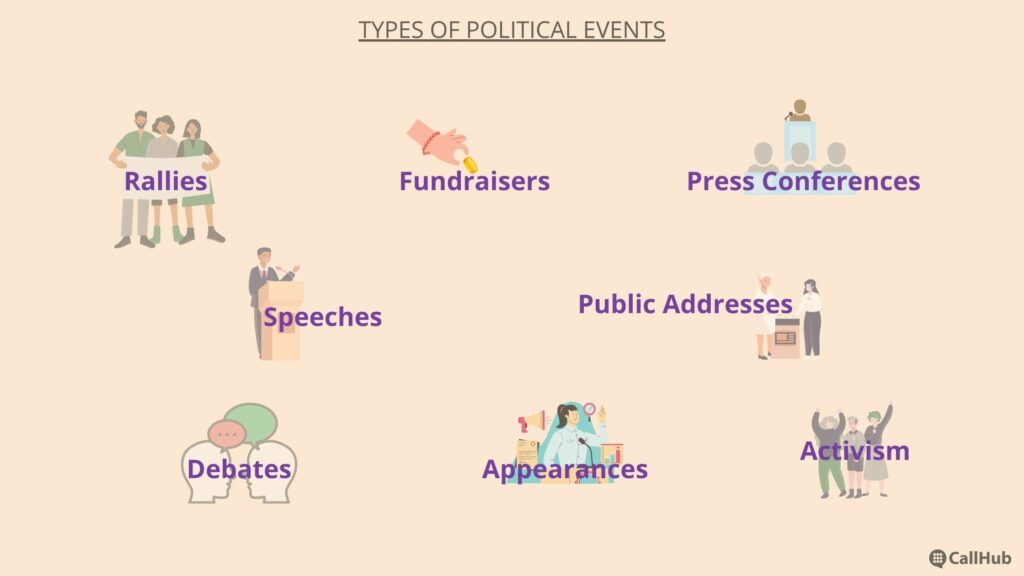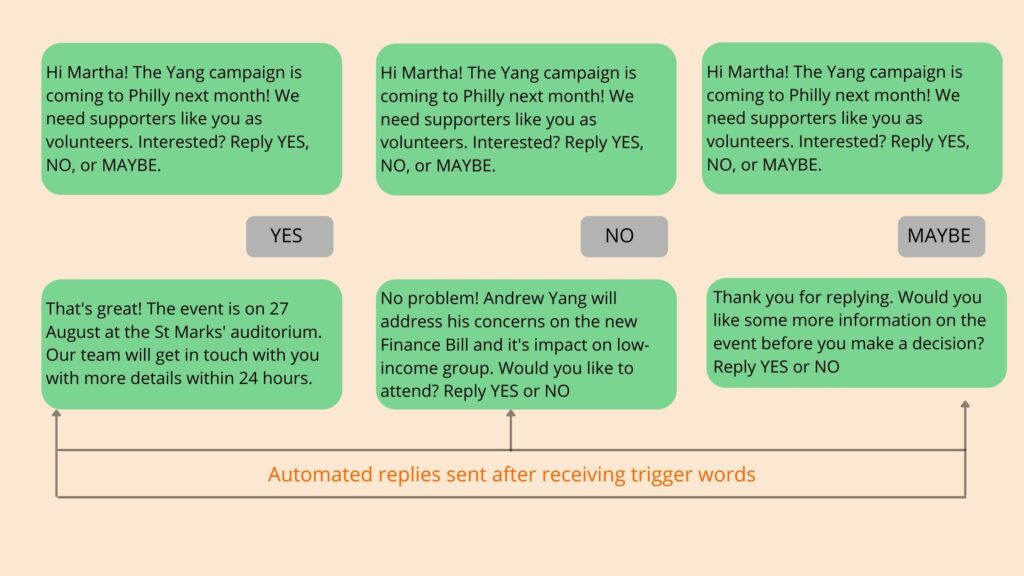The 2012 Presidential campaigns spent upwards of $35.51 million on political events. In the 2020 elections (by far the most expensive US presidential elections), Donald Trump’s campaign spent $2.2 million on a rally alone!
In-person events such as rallies, fundraisers, administrative gatherings, and virtual events are high-stakes. They provide an excellent opportunity to raise money, mobilize voters and set the tone for media coverage (although the Trump campaign spent millions on the rally, the media covered the poor turnout).
Thus, political event planning becomes pertinent, irrespective of how big or local an election you are contesting.
I cover the steps to plan a political event in this blog and end with an actionable checklist.
Political event planning: The vitals
A carefully planned political event can result in successful fundraising, mobilization, and image building. It can be a complicated process. But laying out the vital elements and working towards them can make political event planning a little less cumbersome.
Here we list 10 such actionable elements without which your political rally, fundraising, or virtual event are incomplete.
Outline the type of event organized
The first step of planning a political event is to finalize what type it will be. This depends on your desired outcome. For instance, if you want to raise funds, your event must bring together strong supporters, entertain them and make a strong case that compels them to donate.

When outlining your event type, make sure you cover the following points:
- Nature of event.
- Speech/address/appearances of candidates and sponsors.
- Itinerary (opening act, main event, encores).
- Desired outcome.
- Location.
- Desired attendee size.
- Ideal characteristics of attendees (big donors, vocal supporters, demographic factors).
Allocate a budget
Drawing a budget at the initial stages of political event planning will give you an estimate of:
- The amounts to be directed from existing funds.
- Additional amount to be raised for this event.
- Expected ROI (tangible goal) or intangible outcome (e.g., awareness, support etc.)
By calculating 1 & 2 against 3, you can project the cost of the event.
| Cost of event = (Amount taken from existing funds + amount raised for the event) – ROI |
For instance, if you budget $50,000 for a grand event and you can utilize only $30,000 from the current fund bucket, you must plan to raise the remaining amount from sponsors and other major donors. This budget will inform how much is spent on marketing, communication, logistics and dictate administrative decisions.
Here are some pointers:
- Have a clear demarcation of what is included in the event budget.
- Figure out whether event marketing, communications, etc. come from the event budget or overall marketing/communications budget.
- Let the expenses of previous similar events inform current projections.
- Factor in the current mood of your supporters and plan the event accordingly.
- Keep a 10-15% margin on top of your expense projections.
Mark out the administrative details
Once you know the budget, the next step in political event planning is to mark out actual expenses and administrative details. The following table will help you keep these details organized:
| Expenses | Administrative details |
| Venue | Venue permissions and contracts. |
| Catering | Contracts with caterers. |
| Furniture, podium, decor | Contracts and insurance. |
| Branded decor | Types, number, and assembly |
| Influencer/sponsor travel, accommodation, and food | Contracts, agreements, and arrangement of logistics. |
| Candidate travel and accommodation | Bookings |
| Campaign staff/volunteer travel and accommodation | Bookings and signed agreements/notices. |
Get sponsors on board
High-budget, low-budget, no budget– any political event planning does well with a sponsored backing.
According to FEC regulations, “An SSF may sponsor an event for a candidate to which the general public is invited and pay for the costs of the event as an in-kind contribution to that candidate… [However, a] corporation or labor organization is prohibited from collecting funds or otherwise facilitating contributions in connection with federal elections (other than for the organization’s own SSF).”
Here are some tips to get sponsors on board with your political events:
- Show PACs and community organizations how your views align with their causes. Ensure that your event gets them the deserved recognition.
- Get corporate branding on your decor or merchandise. If you offer visibility, they will shoulder costs.
- Put up products of local businesses in your events.
- Dig into existing sponsors and get them to finance this event.
For more on how to raise funds with sponsorships, read: 5 Campaign Fundraising Strategies We Can Learn From the Pros.
Recruit dedicated volunteers
Volunteers are the backbone of any political event. Without them, any amount of political event planning will flop. So, you want to recruit individuals you would like to be the face of the campaign (right after the candidate). An event volunteer must:
- Be dedicated to the campaign and your cause.
- Be enthusiastic.
- Have some experience in crowd management or political event organization.
- Be well trained by your team.
- Show patience and assertion in high-stress situations.
Getting the right kind of volunteers can be challenging. Especially when you need a huge team. Here’s a proven way to overcome the challenges: Text messages.
Text messages have become the preferred mode of communication for many. By the stage when you are planning a political event, you must also have a responsive SMS contact list. These are your dedicated supporters. They can be an excellent pool of volunteers.
Here’s how to leverage CallHub texting tools to recruit volunteers:
- Segment your existing contact list by the geographical location(s) of your events. You want to target only those supporters residing in your event locations.
- Log in to your CallHub account and create a text broadcast campaign. Add these segmented lists as your contact lists.
- Draft a text survey message, asking if they are open to joining your campaign as a volunteer. Ideally, you send this message only to people who have responded positively to at least one of your previous messages. Add trigger words such as YES, NO, and MAYBE.
- Add an auto-responder to each trigger word. The message could say that a campaign staffer will get in touch with them with further details for the YES respondents. For NO respondents, go for a lower barrier ask, such as asking their interest in attending the event. Nurture the MAYBE respondents and try to turn it into a YES.
- Add a retry text with a different message for non-respondents. (You can see the data of responses on the CallHub Analytics page).
- Create a list of contacts who have shown enthusiasm in volunteering. Engage in personalized one-on-one conversations with them via P2P texting.
- Confirm their interest and send links to relevant web forms or sign-up sheets on the text chat.

Related Reading: 9 Volunteer Recruitment Ideas to Attract Talent During Pandemic
Promote the event online and offline
Now that you have the logistics and volunteer recruitment set, you can start promoting your event. Since political event planning is a dynamic process, this step can be taken even before recruiting volunteers.
However, to avoid undue confusion about the venue or timings, make sure you promote the event after finalizing the venue. The other option is to promote the event but keep the venue information until the contracts are finalized.
Here are some proven ways to promote your event and simultaneously get more people opted in for communications:
- Social media posts and live videos.
- Promotion during previous events.
- Texting.
- Phone banking.
- Sharing your shortcode/long code and keyword across channels (for SMS opt-in).
- Press releases.
- Advertisements.
- Digital advertisements.
Related Reading: Political Marketing – 5 Incredible Campaign Examples You Should Learn From.
Send personal invites
Marketing and promotional activities reach your supporters, no doubt. But they don’t have that extra conviction that personal invitations do. Text messages, calls, and direct mail are excellent ways to send these invites.
Here’s how it goes:
| Target audience | Process | |
| Text messages | Confirmed supporters who have opted in for your text message communications. | Create a list of relevant contacts based on engagement, residence, and such other factors. Target P2P messages informing about the event and inviting them. |
| Phone calls | Highly engaged supporters and donors. | Collect their contact details and make phone calls using an automated dialer (for efficiency). |
| Direct mail | Major donors/engaged supporters who cannot be reached on the phone. | Collect their addresses and draft personal, data-backed letters to post well before the event date. |
Text messages are also excellent tools to send reminders. With a high open rate, quick delivery, and independence from the internet, they can reach your target audience in time and give that last push to attend your event. Learn more: Text Message Reminders – Send Immediate Alerts to Contacts.
Organize security
Have you ever done diligent political event planning if you don’t account for protests, pranks, or heckling? Your candidate is a highly public figure. And if they have a solid support base, they are likely to have strong opponents too. These include mischief-makers.
In May 2012, as President Obama delivered a speech on changed policies concerning the war on terror, an attendee protested. Medea Benjamin heckled him for a good seven minutes. If not for security escorting her out, the situation could have escalated.
Ensure you have security personnel in proportionate numbers (to the expected crowd) and in strategic places during the event. They should also be stationed at the entrance to avoid incidents such as glitter bombing or using other such material to disrupt the event.
Inform the press
Press coverage helps two ways:
- As advertising tools before the event.
- To show impact post-event.
While some media organizations will attend the event organically (without you sending invites), it is an essential part of political event planning to inform and invite them.
Press releases, email blasts, personal interaction all form part of this. Some tips to ensure adequate and desired press coverage are:
- Double-check with media organizations who have supported you in the past and confirm their attendance.
- Have a healthy mix of television, print, and digital organizations at the event.
- Send literature in advance or before the event begins.
- Send press releases before and after the event to increase chances of coverage on both.
Check that everything is in place
Finally, do a roundup of all things you aspired for during the event planning stage. We recommend reserving some time a few days before the event to take a step back and monitor the progress. This way, you still have some buffer to get up to speed if there’s a lag or delay.
We’ve curated a checklist for you to scan through the essentials of political event planning and ensure it goes smoothly.
Here goes.
Political event planning checklist
Here’s the political event planning checklist, divided by task categories.
Finance
- Essentials budgeted for.
- Required budget raised.
- Sponsors confirmation received.
- Sponsor funds received.
- Petty and buffer cash.
- Advance payments to vendors done.
Marketing and promotions
- Event messaging is in place.
- Boards, hoardings, advertisements, online posts have candidate branding.
- Marketing channels have shortcodes/numbers and keyword displayed.
- Campaign literature copies are at least 20% more than expected turnout.
- Sponsors’ branding aligns with contracts.
- Press releases sent out.
- Personal messages to the media sent.
- Press attendance confirmation received.
- Reminders sent to confirmed press attendees.
- Marketing strategies employed.
- Marketing strategies are tracked.
- Event sign ups received from marketing channels.
Volunteers
- Volunteering appeals sent.
- At least 15% more than required volunteers have signed up.
- All volunteers have undergone training.
- Notices and passes for the event distributed.
Logistics
- Security personnel have been arranged.
- Venue is booked.
- Venue permissions acquired and contracts signed.
- Insurance is in place.
- Catering vendor finalized (advance payment done).
- Furniture rental vendor finalized (advance payment done).
- Candidate accommodation sorted.
- Candidate and chief staff travel sorted.
- Staff and volunteer accommodation sorted.
Personal communication and invites
- Personal texts sent to contact lists.
- Follow up with non-respondents.
- Reminders sent to confirmed attendees.
To Conclude
As daunting as political event planning is, the success in attendance or raising funds makes it worth the pain and sweat. The trick is to be personal and compelling in your invites.
We mentioned personal text messages as a means to mobilize supporters to attend or participate in your events. P2P texting is a popular tool among political campaigns to interact with supporters. But how does one utilize it for event management? This guide will explain: Event management strategies and tips using peer-to-peer texting.
Feature image source: Marten Bjork/Unsplash.


